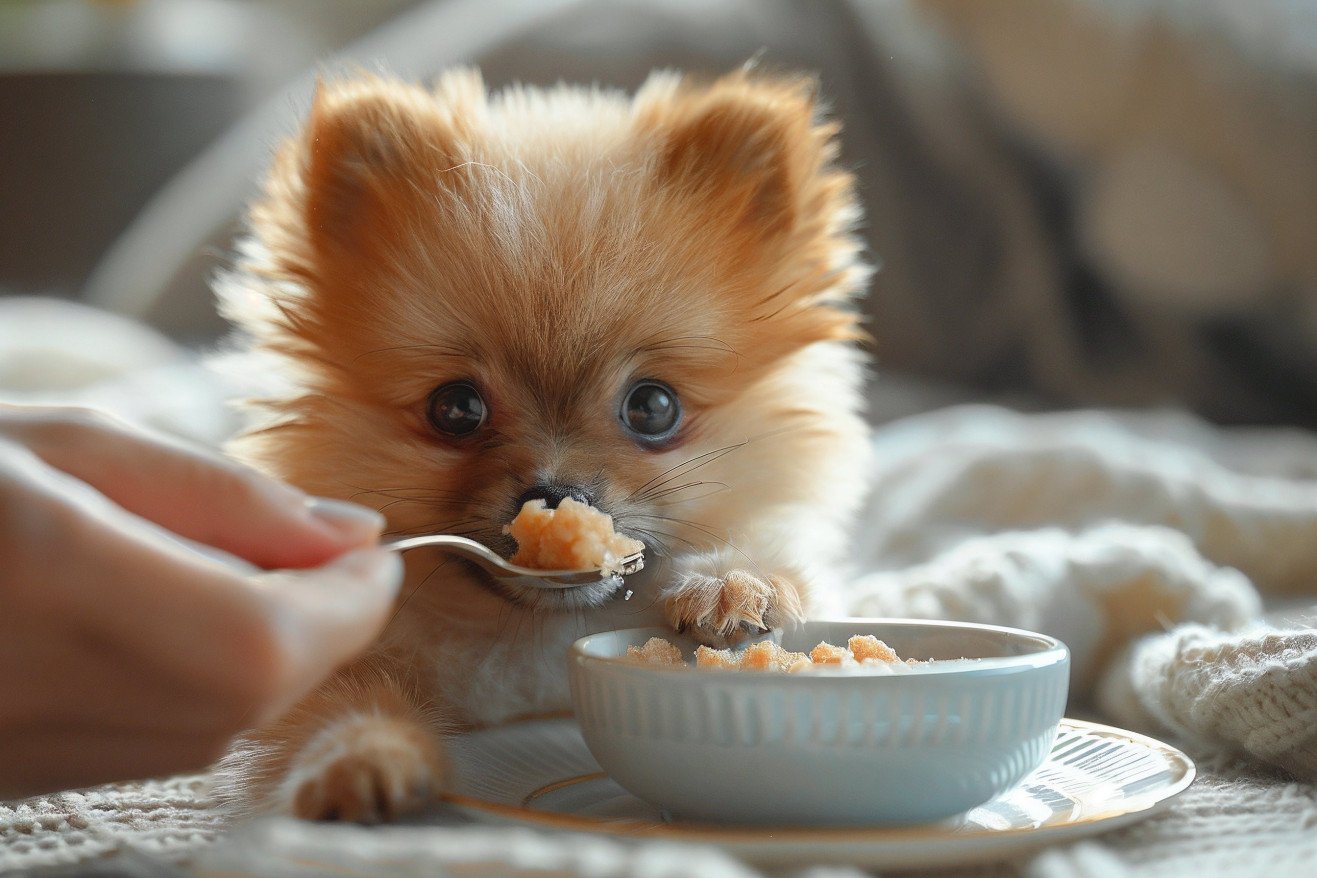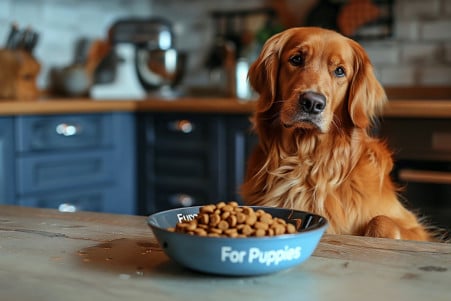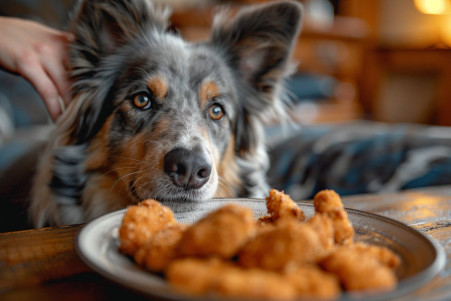Can Dogs Eat Baby Food? Understanding the Risks and Benefits
29 May 2024 • Updated 28 May 2024

Before you give your dog baby food, it's important to know the risks and benefits. While most baby foods are non-toxic for dogs, they are often high in sugars and salts which can lead to obesity, dental issues, and gastrointestinal upset in dogs if fed in excess. Plain, unseasoned varieties are generally safe in moderation, but pet-formulated foods are a healthier choice for a balanced diet.
To help you better understand this, we will look at scientific studies from veterinary nutritionists and pet food regulators. This will include the nutritional content of the most common baby food ingredients, how they affect dogs, and how to make sure your dog's nutritional needs are being met. By learning from trusted experts, you can feel confident in your decision to feed your dog baby food or choose a better option.
Can dogs eat baby food?
Safe and Unsafe Ingredients to Look Out For
If you're considering giving your dog baby food, it's important to know what ingredients to look for and which to avoid. In general, baby food that's made from meat, such as beef, chicken, and turkey baby foods, is safe for dogs. However, you'll want to stay away from any baby food that contains onions, garlic, or the artificial sweetener xylitol because these ingredients can be toxic to dogs.
Baby food made from fruits and vegetables, such as carrots, beans, bananas, and squash, is also generally safe in small amounts, but it should never be the main source of your dog's diet. Always make sure to read the label and avoid any baby food that contains additives or seasonings that may be harmful to your dog's digestive system.
To make sure you're choosing the right baby food for your dog, look for baby food that's plain and unseasoned and made with simple, whole ingredients. Choose baby food that contains meat proteins like chicken or beef over baby food that's made from just fruit since dogs need to get enough protein in their diet. By reading labels carefully, you can make sure you're choosing baby food that's both safe and healthy for your dog and avoiding ingredients that could be harmful.
How Much and How Often to Feed Dogs Baby Food
As noted in Can You Give a Dog Baby Food?, baby food is best used as a special treat for dogs and not as a regular part of their diet. The article stresses the importance of feeding baby food to dogs in moderation and suggests starting with a small amount, like a spoonful, and gradually increasing the serving size.
Although some meat-based and vegetable-based baby foods can be given to dogs in small amounts, Toxic and Dangerous Foods Your Dog Should Never Eat explains that other ingredients, such as onions, garlic, and too much salt or seasoning, can cause digestive problems in dogs. Feeding dogs too much baby food can also result in obesity, dental issues, and digestive discomfort.
The best way to feed baby food to dogs is to do so in moderation as part of their regular diet, either by adding it to their food or mixing it in with their regular dog food. However, pet owners should consult their vet before doing so, especially if their dog has any health issues or dietary restrictions. It's also important to watch for any adverse reactions and adjust the feeding routine accordingly.
Homemade Baby Food Dog Food Recipes
If you want to make your own baby food dog treats, you can control the ingredients and make sure the food is free of any additives or preservatives. Stuck at Home? Whip Up the World's Easiest Dog Treats says that a simple recipe that only includes baby food and flour is a great place to start. The article lists apple, banana, avocado, berries, butternut squash, carrots, chicken, peas, and sweet potato as flavors that are safe and healthy for dogs.
For a more complete homemade dog food recipe, 30-Minute Stovetop Homemade Dog Food recommends a combination of ground turkey, zucchini, spinach, carrots, coconut oil, and eggs. The article also notes that it's important to work with your vet to figure out the right portion sizes based on your dog's weight and activity level.
DIY Homemade Dog Food also explains that making your own dog food can help you make sure the food is free of any questionable additives that are often found in store-bought canned food. The recipe includes a balanced ratio of 50% protein, 25% vegetables, and 25% grains, but you can adjust the ratio to fit your dog's specific needs.
When making homemade baby food for your dog, make sure to cook and puree the ingredients until they're smooth. Proper portioning and storage, including refrigerating and freezing, will also help make sure the food is safe and fresh for your dog.
When to Give Dogs Baby Food: Medical Issues and Special Situations
Per the Tufts University Clinical Nutrition Service, baby food can be a good option for dogs with specific medical issues or clinical needs. The post notes that puppies and kittens can develop congenital issues and other problems, such as diarrhea, even if they were born healthy that require dietary intervention. In these situations, a therapeutic diet that is low in fat and easy to digest, including baby food, can be used to meet their specific nutritional needs during the growth period.
The Shameless Pets post also notes that baby food can be used for dogs with an upset stomach, including vomiting and diarrhea. The post quotes the American Kennel Club, which says that baby food is easy for dogs to eat and digest, which makes it a good option for dogs with gastrointestinal issues or those who are recovering from surgery.
If you're using baby food to meet a dog's dietary needs, it's important to work with a veterinarian or veterinary nutritionist, as the Tufts University post points out. They can help you determine the right amount, frequency, and duration of baby food feedings and help you monitor your dog's progress and make changes as necessary.
How to Transition Dogs Off Baby Food and Back to Regular Dog Food
Transitioning dogs off a baby food diet and back to their regular dog food is an important step to avoid digestive issues. Per How Can I Help My Dog through a Food Transition?, it's important to do this gradually rather than suddenly. The article suggests a 5-7 day transition period in which you gradually increase the amount of the new food in the mixture, starting with 25% new and 75% old and ending with 100% new food.
How to Switch Dog Foods: Transitioning Your Dog's Diet warns that dogs may experience gastrointestinal upset during the transition, such as vomiting, diarrhea, or a lack of appetite. If this happens, the article suggests slowing down the transition and possibly reaching out to a vet. Changing Dog Food: How to Switch Dog Food| Purina US also offers a 7-10 day transition plan to help avoid stomach upset.
To help your dog transition more easily, How to Transition Your Pet to a New Diet - Animal Friends, Inc. suggests keeping meal times consistent, limiting treats, and possibly adding wet food to the new diet to make it more appealing to your dog. It's also important to work with your vet if your dog experiences ongoing digestive issues during the transition.
Conclusion: Weighing the Pros and Cons of Feeding Baby Food to Dogs
While baby food can be a helpful option for dogs in some cases, it should be used with caution and in moderation. The potential downsides, including weight gain, dental problems, and digestive issues, far outweigh the potential benefits unless it is used occasionally as a special treat.
If you do decide to feed your dog baby food, make sure to read the ingredients list to make sure it doesn't contain any potentially harmful ingredients like onions, garlic, or xylitol. Also, look for plain, unseasoned options and choose those that are higher in protein, such as meat-based baby foods, over those that are made from fruits or vegetables. Finally, always talk to your vet before making any significant changes to your dog's diet, especially if your dog has any underlying health issues or dietary restrictions.
In the end, feeding your dog a well-rounded, nutritionally complete diet that is tailored to their specific needs is the best way to ensure their health and well-being. While baby food can be a helpful addition in some cases, it should not replace a nutritionally complete dog food.


